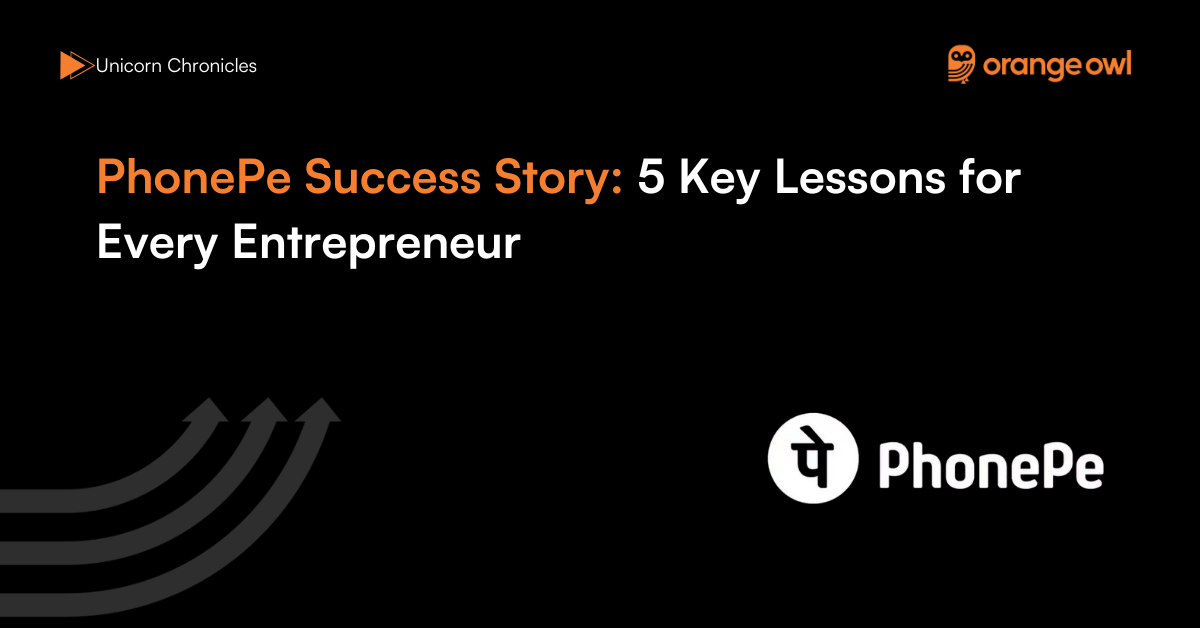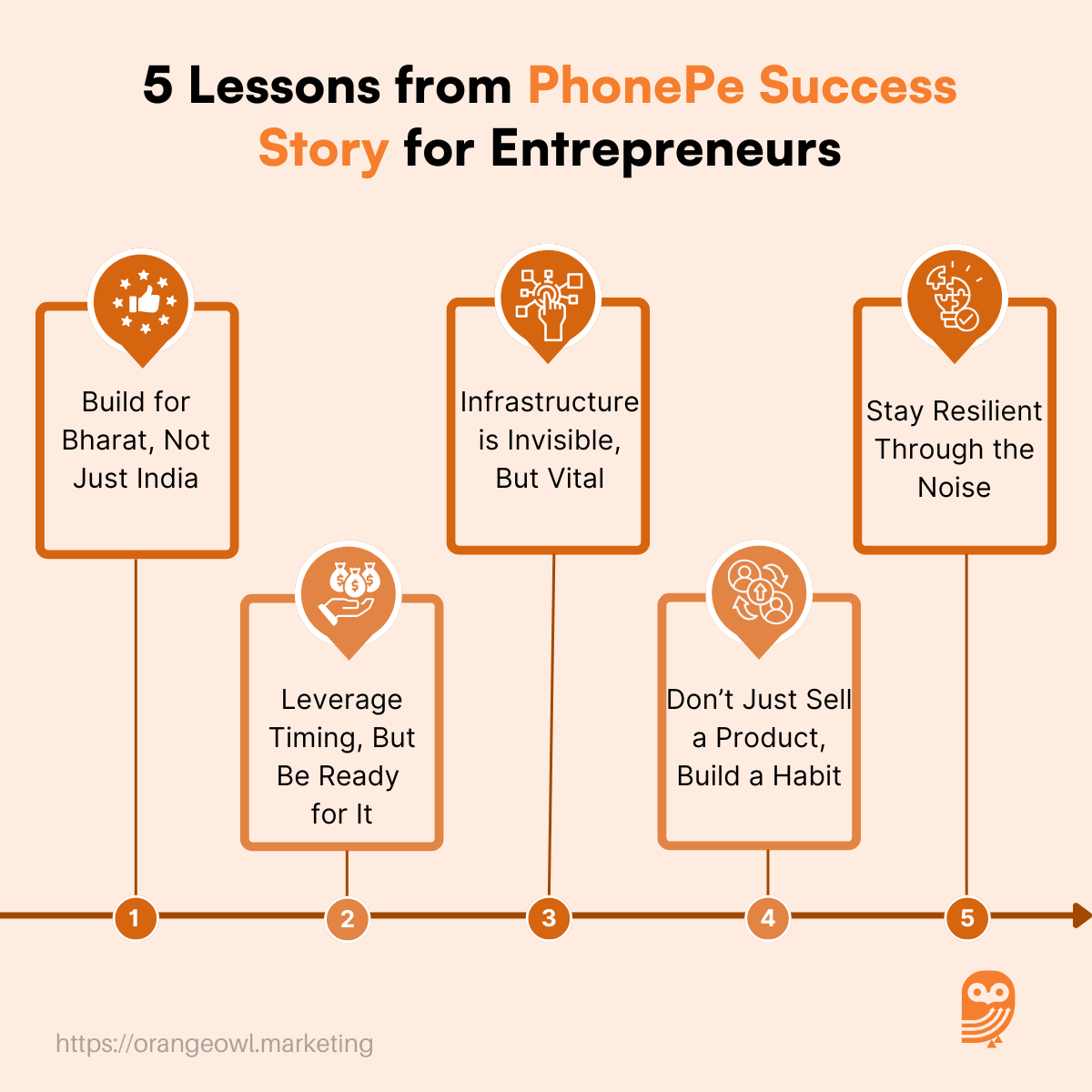PhonePe Success Story: 5 Key Lessons for Every Entrepreneur
Vivek Goel
May 14, 2025

Table of Contents
Introduction
PhonePe Founded in December 2015 by Sameer Nigam, Rahul Chari, and Burzin Engineer, PhonePe has rapidly evolved into one of India’s most trusted and widely used digital payment platforms. Emerging during the transformative period of demonetization and the advent of the Unified Payments Interface (UPI), PhonePe capitalized on the shift towards digital transactions by offering fast, secure, and user-friendly payment solutions.
As of January 2025, PhonePe boasts over 590 million registered users, accounting for nearly one in two Indians. The platform processes over 310 million transactions daily, commanding a 48.4% market share in UPI payments, solidifying its position as a leader in India’s digital payment ecosystem.
PhonePe’s extensive reach includes over 40 million offline merchants across Tier 2, 3, and 4 cities, covering 99% of India’s pin codes. Beyond payments, the company has diversified into financial services, offering insurance, mutual funds, and gold investments, thereby expanding its footprint in the fintech sector.
What sets PhonePe apart is its unwavering focus on addressing India-specific challenges—enabling small retailers to accept QR payments, providing services in multiple Indian languages, and ensuring seamless transactions even in remote areas. The company’s journey exemplifies how a tech-first approach, combined with a deep understanding of local needs, can drive massive adoption and trust.
In the words of Sameer Nigam, CEO of PhonePe:
“We didn’t want to be the fastest. We wanted to be the most trusted. That takes time — and patience.”
PhonePe’s story serves as a modern playbook for scaling with vision, resilience, and a commitment to solving real-world problems.
Origin Story
PhonePe was born out of a critical insight by its co-founders, Sameer Nigam and Rahul Chari, both former senior executives at Flipkart. During their time at the e-commerce giant, they observed a recurring friction point — while shopping was becoming increasingly digital, payments remained a broken experience. Fragmented interfaces, unreliable transactions, and a lack of intuitive design plagued the Indian digital payment landscape.
The duo recognized that India needed more than a simple digital wallet. It needed a homegrown solution tailored to its linguistic, economic, and regional diversity. Inspired by the potential of the newly launched Unified Payments Interface (UPI) and India’s rapid mobile internet adoption, they left Flipkart in 2015 and began building PhonePe with a singular vision: to make payments as easy, fast, and trustworthy as sending a text message.
As Sameer Nigam said in an interview,
“India didn’t need a copy of PayPal. It needed its own, native payment ecosystem built for the diversity and complexity of our people.”
PhonePe officially launched in 2016, just months before India’s landmark demonetization in November that year. This policy shift catapulted the need for digital alternatives, and PhonePe found itself in the perfect storm. Its early bet on UPI integration — when many others were still relying on wallets — gave it a massive first-mover advantage. Within months, millions of users onboarded, drawn by the app’s smooth UX, instant bank-to-bank transfers, and robust transaction success rates.
What started as a small fintech experiment quickly scaled into a household name. From enabling P2P transfers to powering QR-code-based payments at kirana stores, PhonePe’s roots lie in understanding India’s financial pain points — and solving them with clarity, innovation, and empathy.
Business Landscape and Challenges
When PhonePe entered the Indian market in 2016, digital payments were still in their infancy. Cash was king — with over 90% of transactions conducted in physical currency — and the few existing digital options were clunky, fragmented, or lacked trust among users. The landscape was dominated by wallets like Paytm and Freecharge, while the idea of UPI-based direct bank transfers was still nascent.
PhonePe’s mission wasn’t just to build another app — it was to shift consumer behavior in a complex, trust-deficient market. This meant addressing deeply ingrained habits, technical limitations, and a regulatory environment still adapting to rapid innovation. The company had to evangelize the concept of UPI, convince users that digital payments were safe and seamless, and educate small merchants across India on the benefits of accepting digital transactions.
One of the major challenges PhonePe faced in its early days was scalability. As UPI adoption skyrocketed post-demonetization, the system frequently experienced outages and transaction failures. PhonePe knew that every second of downtime, every failed payment, chipped away at user trust — the very foundation of fintech.
“We knew we couldn’t shortcut reliability. Even a few seconds of downtime could erode trust. So we over-invested in infrastructure,” said co-founder and CTO Rahul Chari.
To solve for scale, PhonePe built a highly resilient backend architecture, often going beyond standard practices to ensure 24/7 uptime and smooth transaction flow. This technical backbone became one of its key competitive advantages.
Another uphill battle was onboarding millions of small, offline merchants — kirana stores, chai stalls, vegetable vendors — most of whom had never accepted anything beyond cash. Instead of sending salespeople, PhonePe launched an intuitive merchant app, offered zero-cost onboarding, and created QR kits that were easy to deploy even in the most remote locations.
The regulatory climate also posed frequent uncertainties, with evolving guidelines from the Reserve Bank of India (RBI) and the National Payments Corporation of India (NPCI). But rather than resist, PhonePe actively engaged with policymakers to build a sustainable, compliant ecosystem.
In hindsight, these challenges became PhonePe’s crucible. The company’s focus on long-term trust over short-term growth helped it build a brand synonymous with reliability. It didn’t just survive a crowded, volatile market — it redefined it.
Growth Strategies
PhonePe’s growth was never driven by brute-force advertising or unsustainable cashback wars. Instead, it was rooted in an intimate understanding of the Indian consumer and a sharp focus on solving real problems. One of its first major differentiators was its hyperlocal approach — the app supported over 11 Indian languages, allowing users across diverse linguistic regions to engage with the platform in their native tongue. This inclusivity opened the floodgates for adoption across rural and semi-urban India, where English-first platforms often failed to resonate.
Another critical pillar was its offline merchant acquisition strategy. While many fintech players remained focused on online use cases, PhonePe aggressively onboarded kirana stores, petrol pumps, and local vendors in Tier 2 and Tier 3 cities. By distributing physical QR code kits and simplifying merchant onboarding through its dedicated merchant app, PhonePe ensured digital payments became mainstream even in the most remote pockets of the country.
Strategically, PhonePe made a bold early bet on UPI — eschewing the wallet model that other players were focused on. This decision to align fully with the government’s vision of interoperable, bank-linked payments paid massive dividends post-demonetization, positioning the platform as a frontrunner in India’s digital finance journey.
Beyond payments, PhonePe evolved into a full-stack financial services platform. It introduced offerings like insurance, mutual fund investments, digital gold, and tax payments — allowing users to manage nearly all aspects of their financial lives in one place. This ecosystem strategy increased engagement and deepened customer loyalty.
Marketing too played a key role in scaling the platform, but with a twist — instead of pushy sales or cashback dependency, PhonePe focused on educating users and earning trust. Campaigns emphasized simplicity, security, and daily utility. By 2023, PhonePe was processing over 50% of all UPI transactions in India, according to NPCI data — a staggering figure that underscored the power of relevance, execution, and long-term thinking.
Marketing Strategy
PhonePe’s marketing was designed to resonate with the everyday Indian. Unlike many tech brands that chase virality or edginess, PhonePe prioritized trust, relatability, and simplicity. The brand’s core philosophy was to show — not sell — how digital payments could enhance day-to-day life. Campaigns focused on real, everyday scenarios: a mother paying school fees, a vendor receiving money instantly, or a couple booking gas cylinders through the app.
Sameer Nigam summed it up best in an interview:
“People don’t need to be sold to. They need to be shown how their lives can get simpler.”
This philosophy drove iconic campaigns like “PhonePe karo” and “Karte Ja. Badhte Ja.” — slogans that quickly became part of the national lexicon. Their ads celebrated inclusivity, with characters from all walks of life — from urban millennials to rural shopkeepers — showcasing how PhonePe seamlessly fits into any lifestyle. These consistent, values-driven narratives made PhonePe not just a utility app, but a household name across the country.
5 Key Lessons for Every Entrepreneur
1. Build for Bharat, Not Just India
PhonePe’s phenomenal growth was driven not by appealing to urban elites, but by deeply understanding and serving the diverse needs of “Bharat” — the India beyond metros. The decision to offer the app in 11+ Indian languages and focus on offline merchant onboarding in Tier 2, Tier 3, and rural areas helped PhonePe tap into an underserved and massive market.
This inclusive approach proved that real scale in India comes from solving for everyday Indians — from local vendors to elderly users — rather than catering only to English-speaking smartphone users in big cities.
2. Leverage Timing, But Be Ready for It
Demonetization in late 2016 served as a significant tailwind for digital payments, but PhonePe didn’t just stumble into success. The team had already built a UPI-integrated, mobile-first platform ready to scale.
When the market suddenly shifted, they were among the few with the right product at the right time. This illustrates a crucial entrepreneurial insight: timing can change your trajectory, but only if you’ve done the work in advance. Being prepared to ride a wave is just as important as catching it.

3. Infrastructure is Invisible, But Vital
While most users judge a product based on how it looks and feels, the real test often lies in what they don’t see — the backend infrastructure. PhonePe understood that reliability was paramount in financial services.
The team invested significantly in building scalable, fail-safe systems that could handle millions of transactions without glitches. “Even a few seconds of downtime can erode trust,” as co-founder Rahul Chari said. Entrepreneurs must remember that users might not notice great infrastructure — but they’ll certainly feel its absence.
4. Don’t Just Sell a Product, Build a Habit
PhonePe didn’t rely on one-off offers or gimmicks to grow. Instead, they focused on embedding themselves into users’ everyday routines. Whether it was paying electricity bills, buying groceries, or recharging a phone, PhonePe offered solutions to high-frequency, low-friction tasks.
This created consistent user engagement and turned casual users into loyal customers. The real power of a product lies not just in its utility, but in how naturally it becomes part of someone’s life.
5. Stay Resilient Through the Noise
From regulatory uncertainties and UPI ecosystem bottlenecks to stiff competition from well-funded rivals like Google Pay and Paytm, PhonePe faced its fair share of turbulence. But the founders chose execution over headlines.
They focused on product, infrastructure, and user experience while tuning out distractions. This quiet consistency became their competitive advantage. As Sameer Nigam once said,
“We didn’t want to be the fastest. We wanted to be the most trusted. That takes time — and patience.”
These lessons from PhonePe’s journey highlight that sustainable growth is not about shortcuts or sprints — it’s about building trust, understanding users, and playing the long game.
Conclusion: Key Takeaways from PhonePe’s Journey
PhonePe’s rise is not just a story of digital innovation — it’s a case study in patience, precision, and purpose. At a time when the Indian fintech space was buzzing with hype and funding frenzies, PhonePe chose to stay rooted in solving real problems for real people. It didn’t seek attention through flash-in-the-pan marketing or aggressive cashbacks. Instead, it earned user trust one transaction at a time.
What truly sets PhonePe apart is its deep respect for the Indian consumer. By prioritizing vernacular accessibility, integrating seamlessly with UPI, and onboarding millions of kirana stores, the company created a product that felt native — not foreign — to its users. The platform didn’t just digitize payments; it democratized financial access for hundreds of millions.
Their strategy went beyond digital elegance. Investing heavily in backend infrastructure, PhonePe ensured high uptime and transaction reliability, which is critical in a space where even minor outages can damage trust. From facilitating bill payments and recharges to expanding into mutual funds and insurance, PhonePe slowly but steadily became an integral part of India’s daily financial life.
For entrepreneurs, the lessons from PhonePe’s journey are crystal clear: True innovation lies in understanding your audience deeply, building with humility, and staying committed to solving core problems — even when it’s not glamorous. Consistency, not just creativity, wins the race in crowded markets.
As Sameer Nigam wisely remarked:
“If you’re solving a problem that matters, and you stay at it long enough, the market will reward you.”
In a world chasing overnight success, PhonePe stands as a reminder that long-term trust, built through patient execution and user empathy, is the most valuable currency of all.


